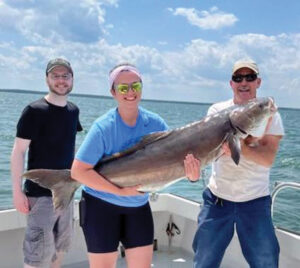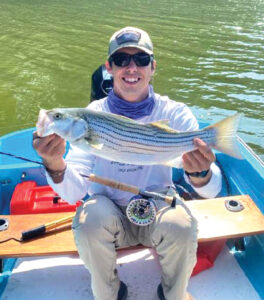Enjoying our fisheries while protecting our resources
Whether you enjoy the heart-pounding, testosterone-filled fight of a 50-plus pound cobia, or just want to catch speckled trout on light tackle, the month of July will fulfill your pleasure.
Cobia fishing began in early June with red-hot action. Cobia travel up the Chesapeake Bay along the shallow water contour lines of both the eastern and western shores. During that time, they travel in groups and feed aggressively. Oftentimes, large cows (row-laden females) are spotted with a smaller male in tow as they prepare to spawn. It is not uncommon to catch one in excess of 60 pounds.

Tim Kinner of Chicago, aboard one of my early season charters, was introduced to one such example—a 62-inch monster that provided a fight only Rocky Balboa could match. Forty-two minutes later, the majestic, brown-colored trophy was landed. The estimated 80-plus pound fish partook in a brief ‘photo op’ and was released unharmed to allow it to drop its roughly half million eggs. That choice to release the fish will certainly provide more cobia for future catches. Creel limits have been set at one fish per person each day with a total per boat not to exceed two each day. The 40-inch minimum size limit, coupled with a maximum of one fish exceeding 50 inches, should keep the stock healthy.
As the season progresses, the early arrivals will spawn and head to deeper waters where they can be found wandering near the surface in search of an easy meal. Additional cobia will move north into the region and action should remain steady throughout this month.
Second to Cobia, speckled trout fishing generates the most excitement locally. These fish are usually found in skinny waters of less than eight feet. Small boats and kayaks are key to reaching the shallow waters where these fish frequent. Feeder creeks, marshes, oyster bottoms and grass beds are home to these tasty specimens. Like most species, the larger trout show up early during the spawn and the smaller fish fill in behind them.
On our inshore charters, we had a few that exceeded 25 inches in mid-June but were greeted with more modest 12-15 inch samples at month’s end. As we move deeper into the summer, larger specimens will again bend the lines. The larger fish we caught could have been prime eating but my clients chose to release them as they were full of eggs. Conservation in the fisheries is vital to the health of stocks. Everyone wants to brag about the big fish they caught, but a quick picture of a spawning fish produces both bragging rights as well as more fish to catch tomorrow.

I have a lot of respect for Charlie Lukacs, a light tackle fisherman that frequents Ingram Bay Marina throughout the season. He targets rockfish, trout and drum. He releases nearly every fish he catches, whether it be on fly or spinning gear. He is 25 years old and already possesses the mindset of a conservation-minded sportsman. He is directing the Bay Bash Fly Fishing Classic which is being held on August 12. It is a remote “Measure and Release” tournament that encompasses the whole bay and its tributaries. Go to BayBash.com for more info.
Bay Health
The health of the Chesapeake Bay has been at the forefront of conservation discussions for decades. It has encompassed debate on many subjects including pollution, fisheries management, erosion, and even the climate.
We can all do our part to reduce pollution in the bay by taking our trash home and following regulations that reduce harmful runoff in our waters.
Fisheries management gets tricky because we have several different user groups that rely on the same resources. Powerful lobbies can skew regulations toward a certain user group while others that are not represented as well are hit with more restrictive laws. It is in the best interest of both commercial as well as recreational users to find a compromise that will ensure the fisheries are healthy well into the future. Greed, both on a corporate as well as individual level, certainly disrupts the best potential outcomes.
The climate discussion is best reserved for an entire article in itself. With that said, all of the other discussions and regulations must also consider the natural cycles and weather phenomena.
The Chesapeake Bay is full of opportunities this month. Targeted species include bluefish, Spanish mackerel, spot, croaker, flounder and red drum.
Enjoy spending time fishing with your children, regardless of their age. Memories made on the water will stir the soul and create a life-long bond.
If you have a heart for conservation, the fishing pleasures fulfilled this July may be a pleasure in the future as well.
Until next time…Fair winds.





